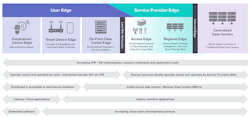>> Electronic Design Resources
.. >> Digital Editions
.. .. >> Top Stories of the Week
.. .. .. >> 2021 Electronic Design Forecasts
What you’ll learn:
- Why private 5G will shake up business models.
- How edge computing and AI will facilitate the new normal.
Following the chaos of 2020, making predictions for the coming year feels more uncertain than ever. But over the past 12 months, a few clear edge-computing trends have begun to emerge that I think will continue in 2021.
For starters, the industry continues to progress toward viewing the edge as a continuum with distinct paradigms, rather than one amorphic entity. Providers are increasingly realizing that despite the benefits of applying similar principles across the continuum as much as possible, there are different high-level edge-computing categories due to inherent tradeoffs between both technology and business models.
The Linux Foundation’s LF Edge taxonomy paper made great strides in defining these tradeoffs, such as whether a use case is latency-sensitive (e.g., video streaming) or critical (e.g., deploying an airbag). Others include whether an edge-compute node is in a data center or is physically accessible in the field (which warrants extra attention to security). And whether a compute resource is capable of application abstraction in the form of containers and virtual machines, or it’s so constrained that it requires embedded software development (see figure).
Given this realization, in 2020, we saw an increasing number of companies building partnerships among providers focused on different parts of the edge continuum to offer a comprehensive solution based on best-in-class ingredients. This trend could turn out to be the overall defining quality of 2021: Non-traditional partnerships and new challengers trying to break into markets historically addressed by others.
Breaking Tradition
We’ve seen the beginnings of this as startups like Vapor IO and EdgeMicro make inroads into providing regional and hyper-local computing resources—which has been the domain of larger telco and IT providers. We also see the crossover from service providers traditionally serving different spaces. For example, DISH Network bought Boost Mobile and has spent billions of dollars purchasing spectrum to offer products and services on top of its own 5G network.
Of course, the public clouds are also aggressively extending their reach into the network edge and beyond. Meanwhile, despite the convenience of these cloud resources, customers increasingly realize the importance of having a multi-cloud strategy. Interestingly, Google’s position with Anthos is cloud-agnostic, and recently Amazon Web Services (AWS) has even started to overtly use the term “multi-cloud” in its messaging.
The Private Side of 5G
You can’t watch television for more than 20 minutes nowadays without seeing a commercial touting a cell provider’s 5G coverage. But in reality, we’re still years away from consumers realizing many benefits from 5G. Sure, you can download a movie a little faster, but does that really change your overall experience? We still need our applications to catch up and take advantage of the lower latency and higher bandwidth before people feel a real shift.
More immediately, private 5G networks will make a more significant impact. This will open doors for non-traditional players, including startups, to offer new services and AI-based innovations at the edge.
In addition to traditional cell providers, we will increasingly see industrial experts providing managed services around networks tailored to customers' unique needs. The reason being, an industrial solutions provider, like Siemens, understands how a factory runs and how to optimize connectivity within that environment in a different way from that of a telco. We will also see traditional networking players partnering with people who understand operations for a private, optimized 5G experience.
Howdy, Partner
Further expanding on this theme, expect to see an accelerating trend in 2021 of IT-centric players partnering up with leading industrial providers who understand the unique contexts of industrial environments because IT practices around security, management, and data science don’t equal domain knowledge. Similarly, more industrial players will stop investing in building out their own cloud platforms. Instead, they will adopt platforms from the cloud scalers and focus on their domain-specific knowledge and products.
Rockwell Automation is an excellent example of this trend as the company is building out its industrial IoT and edge-computing strategy with an open approach.
In general, confusion over edge taxonomies will wane, and standards will begin to take hold. That opens the door to more pure-play providers that are experts in one discipline of the stack, compared to the hundreds of generic platforms we’ve seen over the past five years stemming from the IoT trend.
Edge and AI Facilitate the New Normal
Despite the availability of COVID vaccines, remote work will be a new normal for many. In 2021, we will see more transformation in the cloud and the acceleration of edge computing due to the need to offload networks. New AI-driven innovations will emerge to enhance productivity for remote workers and help them balance work and home life.
AI Gets Skinnier
The TinyML conversation that started heating up in late 2019 will reach full-on buzz in 2021. This is the practice of deploying small inferencing models optimized for highly constrained, microcontroller-based devices. For example, the “Hey Alexa” wake command for an Amazon Echo is recognized locally by a TinyML model, which triggers opening the connection to their cloud-based servers for a session.
TinyML algorithms will increasingly be used for a localized analysis of simple voice and gesture commands. These involve familiar sounds such as a gunshot or a baby crying, assessing location and orientation, environmental conditions, vital signs, and so forth.
This trend will help further the growing realization by the telcos and traditional IT players that not all edge processing will happen in a data center, and the edge is indeed a continuum.
Kubernetes Heads South
With K3S and the recent introduction of K0S, the Kubernetes wave will continue to flow “southbound” toward more constrained edge-computing devices. This will spin up more focus on the right security models for deployments outside of physically secure data centers. It will also drive more partnerships between companies with expertise in edge data-center deployments and those that address the unique needs of managing and securing compute resources distributed in the field.
Learning Gets Federated
The concept of federated learning has shown promise for several years, but it’s a challenging prospect. This space will evolve in 2021 out of necessity to provide the benefits of decentralization for privacy, autonomy, data sovereignty, and bandwidth savings while centralizing results from distributed data zones to eliminate regional bias.
AI vs. AI
Data trust will be an increasingly hot topic in 2021. This is due to the rapidly growing challenge of dealing with the proliferation of deep fakes that can skew business results, drive false sentiments on social media, or worse. The industry will respond by leveraging AI to combat rogue AI and further exploring the concept of data confidence fabrics.
Wrapping Up
One of the encouraging developments of 2020 that has great momentum heading into the new year is establishing definitions and taxonomies around edge computing.
We’re getting out of the initial buzz period around edge computing, during which various industries (cloud, telco, IT, OT/industrial, consumer) defined the space with a strong bias toward their own interests. Plus, they used ambiguous terms like “thin and thick” and “near and far” that mean different things to different people. A common vocabulary goes a long way toward clearing up confusion and breaking challenges down into manageable scopes.
A key theme of 2021 and beyond will be companies adopting more open infrastructure and building strategic ecosystems of technology and service providers that provide unique value-add on top of their own focused offers. This will include non-traditional partnerships, adapting business models and new challengers.
In the end, domain knowledge rises above everything else, and given the diversity of the edge, it’s not productive to try to tackle the entire solution stack on your own. We need to form meaningful partnerships with experts in each of the unique challenges spanning the edge continuum. It’s more than saying “it takes a village.” We need to build it.
>> Electronic Design Resources
.. >> Digital Editions
.. .. >> Top Stories of the Week
.. .. .. >> 2021 Electronic Design Forecasts

